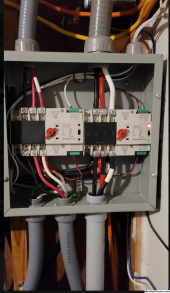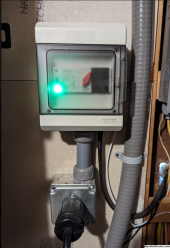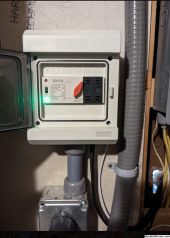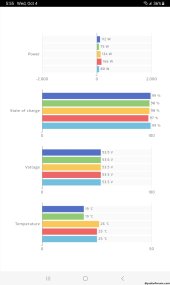You are using an out of date browser. It may not display this or other websites correctly.
You should upgrade or use an alternative browser.
You should upgrade or use an alternative browser.
My build thread
- Thread starter timselectric
- Start date
wattmatters
Solar Wizard
In Australia a meter upgrade is compulsory when installing grid-tied solar PV. Had ours for very nearly 5-years. It's been a good thing actually as I was able to access better tariff options.
I do also like being able to download the metering data so I have exactly what the utility uses for billing and be able to track our grid energy consumption. My own metering does it too but there's always some discrepancy/error so having exactly what the retailer uses is helpful.
It also means we can get retail plan comparisons done in a jiffy with the federal govt plan comparison site. All retailers are by law required to have their plans on the govt comparison site. I plug in my metering number and it analyses the many hundreds of retail plans to show the options sorted by lowest overall cost.
We now import less than 1/10th of the grid energy that we used to 6-7 years ago.
I do also like being able to download the metering data so I have exactly what the utility uses for billing and be able to track our grid energy consumption. My own metering does it too but there's always some discrepancy/error so having exactly what the retailer uses is helpful.
It also means we can get retail plan comparisons done in a jiffy with the federal govt plan comparison site. All retailers are by law required to have their plans on the govt comparison site. I plug in my metering number and it analyses the many hundreds of retail plans to show the options sorted by lowest overall cost.
We now import less than 1/10th of the grid energy that we used to 6-7 years ago.
timselectric
If I can do it, you can do it.
- Joined
- Feb 5, 2022
- Messages
- 19,113
Same here, in the states.In Australia a meter upgrade is compulsory when installing grid-tied solar PV.
This meter upgrade was to save the utility company money. And the guy who used to read my meter every month, is probably now unemployed.
I'm not sure how many meters in the area were changed. But I was notified that it was going to happen within the next 10 days. And that notification was sent to me 2 months ago.
I'm guessing that the process isn't going as quickly as they were expecting.
About two years after we bought our place here in rural Maine, and after we installed mini-splits, the power company sent a person out to see why our usage was so much higher than in past years. They hadn't read our meters (we have two, one on each main building) for about six months as we live down a road they don't want to travel in their little 2WD trucks in winter. After they did this, they told us that the meter at the guest house had been underreporting usage for about 5-6 months. We hadn't noticed it because the entire property gets lumped into one main bill, and all of it was thrown off by the switch to heat pumps.. Anyway, they charged us several hundred dollars the next month to make up for their loss, and we had to pay it. But they also installed remote-reporting meters, and I installed an Emporia Vue in each building. Those two systems have been in sync since then, but that whole fiasco was a big part of the motivation for us to install solar in our outbuildings, and in a new house we're building a few miles away. I'm still not convinced that meter was really off, but it was cheaper to pay it than fight them. and it sure soured me on the utility company.
ksmithaz1
Solar / EV Junkie
I used one of these mounted in a box for a while. Not very expensive, Blue top, kind of obnoxious to wire with #4. I'd give it to you if I can remember where I put it, I think I have two. When I re-wired I decided to roll with a small din box for the chargeverter, and replaced this 80A relay that fed a pedestal and mounted it on a din rail with my 100A transfer switch to my pedestal with this (Picture below Left switch, right feeds breaker panel/2AWG):TWTADE/JQX-62F-2Z Coil Voltage AC 220V 80A DPDT Electronmagnetic Relay,High Power Relay (AC 220V) https://a.co/d/2zgQT54
These are all over amazon. This particular one (above) is 100A 4-pole and has worked flawlessly thus far as a transfer switch as well as a simple computer controlled relay for my outside pedestal. I have two spares in the box just in case.
This was so successful I bought two (2) 'Jotta' 2 pole units for my chargeverter (farther down). They have the contacts to the right and the switching to the left. I bought two, the first one failed within a month, it refused to auto-switch. I replaced it with the second one and thus far it has worked as advertised, though it does not get the abuse of the 100A primary transfer switch which flips twice a day, or whenever I'm goofing around with the system ;-). I need to buy a spare, but it will be annoying if the contacts flip over to the left side so I'll probably get the same one, no rush as this is not a critical switch.
This does however create a neat and tidy appearance, the DIN box has a Neutral and ground bus bar, so the wiring is pretty nice and you don't have wires sticking out perpendicular. The common is underneath on the bottom like the 4-pole units. It has a manual/auto switch. I wired the secondary relay to the primary input, so it simply forces itself off. I wired the primary relay to my control computer which puts power on the relay on a schedule. It's currently manually OFF, the green lights indicate the secondary relay is powered. The primary will turn on/red at 2100, but I'm not currently running the CV, because until this past Tuesday, the batteries were running out at 2200 and the chargeverter would not keep up with my nighttime load very well. That load seems to be much lower now that the nighttime temps have fallen below 90, last night my batteries lasted until 0200. Like @timselectric at some point I want to be able to not worry about whatever I want to do. I have my CV's tuned to about 48.5V which charges the batteries to around 20%. Now that I have tamed the modbus on the inverters, I have access to battery SOC, load and output, so moving forward I will be making decisions to turn the relay on based on Time, load and SOC. ie Don't bother with the CV if my load is over 4KW, or if I'm going to have to be on charging for more than 5 or 6 hours or something. Further when I get my next rack of batteries, I will start supplementing if the SOC falls below 15% or something. To try and always ensure power even if the grid goes down at night. Dunno yet, that's what makes it fun!
I don't want to



timselectric
If I can do it, you can do it.
- Joined
- Feb 5, 2022
- Messages
- 19,113
I have those as well. But for smaller loads, the relay is simpler and faster transfer.
ksmithaz1
Solar / EV Junkie
The TWTADE relay was definitely quite a bit faster! These cheap transfer switches are also noticably faster in one direction than the other, but for the life of me I can't remember which which is which. I pulled the broken one apart, it's a rotating switch vs pull up/down magnetic contacts on the TWTADE. The big difference is the ability to manually flip them which is kind of nice when you are playing around.I have those as well. But for smaller loads, the relay is simpler and faster transfer.
Smart way to use a bad panel for good use to create an aesthetic view of the roof!
timselectric
If I can do it, you can do it.
- Joined
- Feb 5, 2022
- Messages
- 19,113
Lt.Dan
Solar Wizard
Cool! How do you handle switching between viewing the 2 of them? Is it a pain?Finally found some free time, yesterday.
5 BMS's monitored by the second Solar Assistant.
View attachment 171001
timselectric
If I can do it, you can do it.
- Joined
- Feb 5, 2022
- Messages
- 19,113
Lt.Dan
Solar Wizard
It doesn't remember the login of whatever the last one used? Or is it still the same email/login?
timselectric
If I can do it, you can do it.
- Joined
- Feb 5, 2022
- Messages
- 19,113
NCislander
Solar Enthusiast
Very coolFinally found some free time, yesterday.
5 BMS's monitored by the second Solar Assistant.
View attachment 171001
JakAHearts
New Member
@timselectric I think I saw you mention in another thread that youre using a chargeverter so that you stay off grid but can still use grid power to charge your battery bank when needed. I cant find that now but was that you and can you tell me about that briefly? Im thinking of going this way.
timselectric
If I can do it, you can do it.
- Joined
- Feb 5, 2022
- Messages
- 19,113
The chargeverter is set at 48.3v currently. This is just a personal preference.@timselectric I think I saw you mention in another thread that youre using a chargeverter so that you stay off grid but can still use grid power to charge your battery bank when needed. I cant find that now but was that you and can you tell me about that briefly? Im thinking of going this way.
If my batteries ever get that low. The chargeverter takes over the loads, and just floats the batteries at that voltage.
When the sun returns, it takes over. And the chargeverter goes back to idling.
Lt.Dan
Solar Wizard
Does the chargeverter have much of a stand by consumption?The chargeverter is set at 48.3v currently. This is just a personal preference.
If my batteries ever get that low. The chargeverter takes over the loads, and just floats the batteries at that voltage.
When the sun returns, it takes over. And the chargeverter goes back to idling.
timselectric
If I can do it, you can do it.
- Joined
- Feb 5, 2022
- Messages
- 19,113
Literally, just a couple of watts.
Haven't been able to actually measure it.
Haven't been able to actually measure it.
timselectric
If I can do it, you can do it.
- Joined
- Feb 5, 2022
- Messages
- 19,113
Need to add to this.The chargeverter is set at 48.3v currently. This is just a personal preference.
If my batteries ever get that low. The chargeverter takes over the loads, and just floats the batteries at that voltage.
When the sun returns, it takes over. And the chargeverter goes back to idling.
I forgot about the relay that turns the chargeverter AC on and off. It's been setup for a while. And it hasn't ever been used. (Only tested it once, to verify that it will work)
It's controlled by the dry contacts. Like a generator would be.
Turns on at 48v
Turns off at 50v
JakAHearts
New Member
Because my roof space (the only non shaded area on my property, sadly) is limited and I won't be able to add panels, what do you think that longevity of such a method is if the charger is used frequently? Should I just bite the bullet and go grid tied?The chargeverter is set at 48.3v currently. This is just a personal preference.
If my batteries ever get that low. The chargeverter takes over the loads, and just floats the batteries at that voltage.
When the sun returns, it takes over. And the chargeverter goes back to idling.
Last edited:
Similar threads
- Replies
- 20
- Views
- 892
- Replies
- 4
- Views
- 278
- Replies
- 18
- Views
- 879
- Replies
- 0
- Views
- 124





